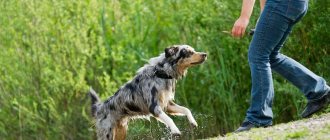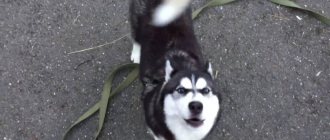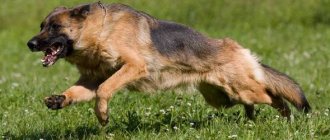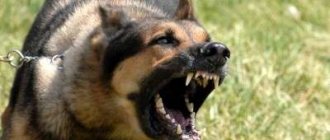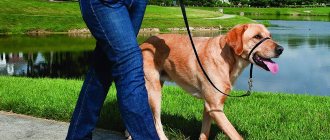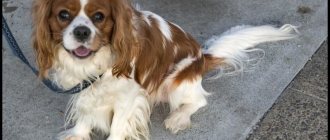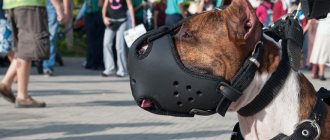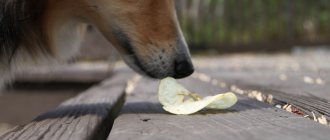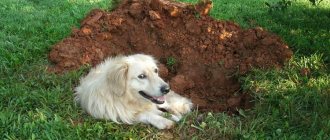Why is the "aport" command needed?
The “fetch” command is one of the mandatory ones when passing the OKD (general training course), but it is also used during walks for entertainment purposes.
Spending time with your pet is more fun with a toy - almost any dog loves to run after some object and bring it to the owner.
In addition, all animals need exercise, and the fetch command is a great way to burn off energy.
How to teach a dog the fetch command
Retrieving is a rather complex skill, but most dogs develop it relatively easily and are traditionally included in the general training course (GTC).
What does the "Aport" command mean? On the “Fetch” command, the dog must pick up the thing thrown by the trainer, return to him, go around to the right and behind, and then sit at the left leg, waiting for the trainer to pick up the thing.
The dog must not take off and fly towards the thrown thing until the trainer gives the command, and it should not throw the thing until the trainer himself bends down and picks it up.
The “Fetch” exercise differs from the usual game of fetch in that in this case the dog performs all actions only on command.
You can start teaching the command when the dog is 7-8 months old and knows the commands “Come” , “Near” , “Sit” . So, let's look at how to teach a dog the “Fetch” command.
Teaching a dog to take an item
First, you need to get the dog, at the command “Fetch,” to take the offered thing in its teeth and hold it for several seconds until you command “Give.”
Find a quiet place, put your dog on a leash and sit him in the “near” position. Transfer the leash to your left hand, and take an object in your right hand and offer it to the dog. As an object, you can use a stick, an old glove or any other thing that the dog will enjoy holding.
Do not use food, toys or items with long fur. Tease your dog with an object, and when he wants to grab the object, say “Fetch!” and let me do it. As soon as the dog grabs the object, sincerely praise him and repeat the command.
If the dog is holding the object sluggishly and without enthusiasm, pull it , this will force the dog to tighten its grip. Praise again and repeat the command. Now say “Give”, take the object, praise and give a treat.
Until this point, the treat should be hidden in your pocket, since no dog will hold the object if at the same time you wave a treat in front of its nose.
If your dog refuses to take the item, put it in the mouth yourself and lightly pinch the muzzle with your fingers (at first for 1-2 seconds) so that the dog cannot spit it out. After this, immediately actively praise and give a treat. Do not try to force an object into your dog's teeth or be too rough as this will cause a negative reaction.
Teaching a dog to carry a thing
Now that the dog has learned to take the thing without problems, it is necessary to teach it to move with the thing in its teeth. Give the dog an object, command “Near” and walk 5-6 steps. Then stop, grab the object and say “Give.” Praise and give a treat.
If the dog spits out an object after you commanded “Near”, do not get angry - it is difficult for the dog to do 2 things at the same time. Stop, order her to sit and repeat the procedure described above.
If, after numerous repetitions, the dog still does it wrong, do not say the command “Near”, but give him an object and just quietly pull him with the leash.
Subsequently, ensure that he finally learns to move on the command “Nearby”.
Teaching a dog to pick up something from the ground
To teach your dog to pick up something from the ground and present it, do the following: put your dog on a leash and tell him to sit. Then show her the thing and throw it forward a short distance and so that the object is in the dog’s line of sight (you need to throw it at arm’s length from the bottom up).
Simultaneously with the throw, say “Fetch!”, point your hand at the object and, together with the dog on a leash, head towards it. When you approach the object, repeat the command again. If the dog does not understand what to do, move the thing with your foot and repeat the command .
Choosing a retrieval item
To pass the general training course, a specialized retrieval item is required - a dumbbell.
If you are planning to teach your dog the “fetch” command not for the purpose of passing sports standards, you can choose almost any object - as a rule, it is a dog toy.
The toy should not be too light so that you can throw it to the desired distance without any problems.
Choose an item based on the size of the dog. Do not take a toy that is too large or small, because it will be uncomfortable for your pet and subsequently unpleasant to work with such an item.
Pet stores offer a wide range of toys: ropes, balls on ropes, grips, rings, rubber bones and others.
It is important to consider your pet's taste preferences.
Does your dog like hard toys? Or does your pet have a strong grip and soft, fragile objects are not suitable for him? Does your pet prefer balls or ropes? Maybe your dog will be more attracted to squeaky toys?
Based on the animal’s preferences, choose the most convenient and desirable toy for the dog - this is very important in building motivation, especially in the early stages of training.
It is not recommended to use sticks found on the street, as the animal may pick up a splinter in its mouth.
As a last resort, you can use a stick if you inspect it carefully. The stick should be hard and not falling apart, without any protruding shoots.
Teaching the “Aport” command with a gesture
The “Fetch” command corresponds to a gesture - raising the right hand with the palm up in the direction where the object was thrown.
Selecting an object to practice the “Aport” command
You yourself choose the subject to practice the command. This can be either specialized items from a pet store or a simple stick picked up from the street. The main thing is that the item is clean and safe for the animal. And so we list what is suitable:
- Special equipment: items with a tag, sticks with ropes, bones and toys for dogs.
- Frisbee (flying saucer).
- Balls (not rubber), tennis balls work well.
The following are not suitable for fetch: soft, fur, bursting, fragile objects that quickly get dirty and become unusable. At first, it is best to use one object to practice the “Fetch!” command.
Choosing a place to study
The first stage of training, when you just teach the dog the “take” command, can take place at home. The pet does not need to run anywhere, and training will take place in a quiet home environment, when the dog will not be distracted by anything.
In the future, when the pet has to learn to run after a toy, it is better to carry out training on the street, since doing this at home, especially on a sliding parquet floor, will be inconvenient and unsafe for the pet.
Choose a place where people or dogs will not pass by so that your pet will not be distracted or disturb others.
The place should be an open space so that the pet does not run into anything or touch anything during training and execution of the command.
Do not train on wet grass after rain, as the animal may slip and get injured.
Also, you should not exercise on asphalt surfaces; such a coating does not absorb shock, which is harmful to your pet’s joints when he runs on it.
Algorithm for training a puppy and an adult dog
Teaching your pet the “take” command
Take a toy and play a prank on the dog. Play tug of war, drag the toy along the floor. Stop the game at the most interesting moment, when the pet is in the midst of a hobby.
Wait a second and encourage your dog to grab the toy again. If your pet doesn't take the item, start playing it again.
As soon as the dog takes the toy, after a few seconds ask the animal to let it go. Repeat this several times, alternating with a long game so that the dog does not get bored with the learning process.
Enter the voice command “take.” Gradually increase the time you hold the toy.
Advice : if the animal does not want to play, remove all dog toys from free access, forcing the dog to play exclusively with you, and not with himself. Do not play with your pet after a long walk when the animal is tired.
Offer your dog a toy when he is full of strength and energy. To prank your dog, you can tie a toy to a leash and start dragging it away from your pet, and also run away from the animal with the toy. As soon as the dog grabs the “prey”, rejoice greatly at his victory and continue to play energetically with your pet.
It is important to let the dog win, but not to give in too much yourself. Who is interested in fighting with an opponent who is always winning or, conversely, losing?
Don’t let your animal get exhausted during the game; end at the most interesting moment, when your pet is eager to play more.
Offer your dog play at home, and later on outside in quiet, calm places.
Gradually, you can play with the animal in more busy places, teaching the dog to play with you regardless of the situation.
Teaching your pet to pick up something from the ground
After the dog has learned the command “take”, you can safely move on to the next stage - learning to pick up things from the ground.
This skill is learned quickly and effortlessly. First, let your pet remember the “take” command by repeating it several times.
Next, place the toy (the same one that was used in the previous skill) on the ground and command “take it.”
If your pet doesn't understand the task, help him with gestures and pointing. You can throw the toy away a little, encouraging your pet's instinct to catch up and grab the object.
As soon as the dog takes the toy from the ground, say the command “give it back.” Repeat this several times until your pet masters the skill.
Advice: if the dog doesn’t want to give you the toy and starts to get greedy, start running away from the dog in the opposite direction.
Do not run after your pet in an attempt to take away an object - this will irritate the animal even more.
You can also offer your dog a mutually beneficial exchange: she gives you an object, and you give her a treat or another toy that is valuable to her.
Always negotiate with your dog and look for compromises. Do not try to take the item by force, otherwise the animal’s motivation will decrease and it will be unpleasant for him to cooperate with you.
Teaching a dog to carry a thing
Repeat the “grab” exercise with the object on the ground several times. Next, throw the object a little further away from the dog, also commanding “take.” If the dog successfully brings you the object, increase the distance of throwing the toy.
You can enter the “fetch” command at this stage, but you can also leave the “take” command - the dog does not understand human language and it does not matter to her what name you give the command.
As an addition, ask your pet to follow the "sit" command and, while holding it, discard the object. The dog should not explode without your command. If the dog sits quietly, command “fetch.”
Advice : if the pet willingly runs after the toy, but is in no hurry to bring it back, then after the dog grabs the object, run away from it in the opposite direction.
This will encourage the animal to catch up with you, and in this case the dog will speed up. Don't stand in one place if your dog has this problem.
Join the game yourself and show your pet how cool it is to play with the owner and bring him a toy.
Teaching a dog to retain an edible “fetch”
Repeat the “fetch” exercise with a toy. You can add variety and throw other various objects to your pet so that he understands that the owner can bring not only toys, but also other things.
Next, take a large piece of food that the dog doesn't really like. First, the piece should be large enough to make it more comfortable and easier for the dog to understand the task.
For example, you can take a piece of bread. Place the piece on the ground next to you and give your pet the “take it” command. If the dog successfully took and gave you a piece, praise him with some kind of treat, after which you can start throwing food over a longer distance with the “fetch” command.
Gradually, move on to types of food that are more tasty for your pet. It is important to let the dog know that if he holds a treat in his mouth and does not eat it, this will be followed by praise with an even more delicious treat.
Fetch training with a toy
Take your pet on a leash (it should not be very long, but not short either). Hold it in your left hand. Take your starting position. Take out the play object with your right hand and show it to the dog. Then give the command “Sit!” and place the dog in the starting position. Always do it this way. The signal to play should not be the appearance of a toy in your hands, but a special command (for example, “Up!”). You can come up with your own version.
Take a short pause, after which give the command “Up!” and start the game. It should be similar to pursuit: the movement of the toy should remind the pet of the movement of a living object. The speed of movement of the object should be such that the dog does not lose hope of catching it, and with it, interest in the game.
When the dog has finally caught up with the toy, it’s time to move on to the next stage of the game - play fighting. A person can hold the toy with his hands or feet, pull it in different directions, drag it behind him, jerk it, twist it, lift it high above the ground, hold it while intensively stroking or spanking the dog, and the like. At first, this struggle should be short and not very intense. Every 5-7 seconds of such a fight, you should let go of the toy, take a few steps back, pulling the dog by the leash, and again enter into a play fight.
The next stage of the game is giving away the item. This exercise will teach your dog that play is much more involved than just grabbing a toy and carrying it away. Play is all about fighting and winning, and dogs really enjoy both. Soon the pet will begin to come running to you with a toy in its teeth and demand that you play with it again.
It is important to teach the dog to give up the object, and this should be done at the very beginning of the game, when the dog is not yet very excited. The dog should be made to understand that giving the object to the owner does not mean the end of the game. This is its mandatory element.
Stop. Drop the leash and grab the toy with your left hand. Give the dog the command “Give!” and bring a piece of treat to her nose - that is, make an exchange. To get the food, the dog will have to let go of the toy. Then raise the toy higher so your dog can't reach it. Feed her 3 to 5 pieces of food, give the command to play again and start playing as described above. Repeat this play cycle 5-7 times, then take a break - put the toy away and switch to any other activity.
When you see that your dog eagerly brings you a toy to continue the game and easily gives it back, modify the game situation. Start the game with your dog on a leash. After the pursuit stage, do not give her the opportunity to catch up with the toy, but throw it aside at a distance of one or two meters. Let your dog grab it and take 5-7 steps back. In principle, the dog itself should already bring you an object in order to start a play fight, but if this does not happen, pull it towards you with a leash and start a play fight. After a short pause, offer the dog to chase and throw the toy away again. Repeat this game exercise several times and take a break.
As your dog becomes more trained, throw away the toy more often and have the dog bring it back to you, and at some point play fighting will drop out of this cycle. This means that you have trained your dog to bring you a discarded object. But while walking, play all kinds of games with your dog, otherwise he may get bored of doing the same thing.
Passive inflection method
This method involves physically influencing the animal in an attempt to help it learn a command.
The trainer mechanically sets the pet to the correct position, and then reinforces it by praising the dog with a treat.
In the “fetch” command, using this method, the owner opens the dog’s mouth and puts an object in there, holding it so that the animal does not spit out the thing if necessary, after which he praises the pet with a treat.
Yes, your pet can be taught the “fetch” command using this method. But is it worth it?
Firstly, not all dogs calmly allow a person to get into their personal space, and even in such an impudent manner.
In addition, almost any animal will be unpleasant when its mouth is forcibly opened and an object is shoved into it, and even not allowed to spit it out.
Secondly, when the dog is physically manipulated, his attention will be drawn to the trainer and his actions towards him, and not to teaching the command.
Thirdly, training will not give any mental development to the dog, since the trainer deprives the pet of the opportunity to think for himself, because the owner does everything for him. Whether to resort to this method is up to you.
Basic mistakes
- Training without playing with your pet . In this case, playing with an animal is an encouragement and relieves the brain for him, because the dog cannot think hard about a task for a long time. Without play, the dog will quickly get bored with the training process.
- Working without a leash on the street when the dog runs away and does not obey . If you know that a dog in an outdoor environment may at some point run away or become greedy with a toy in his mouth, tie a long thin leash or rope to his collar. So, if something happens, you can stop the animal from escaping. The dog should not be allowed to run away during training, otherwise the animal will associate the “fetch” command with disobedience behavior.
- Lack of your involvement in the game . If you stand there and don’t react emotionally to your pet’s success, he will simply become bored. Put more energy and emotion into training, and the animal will be much more willing to cooperate with you.
- Taking away a toy after the command “give it back” every time without reward with a treat . If every time after the command “give” you take away a toy from your dog without offering a treat in return, your pet will associate this command with a negative consequence, and the next time he will not give you the item and will begin to be greedy.
Training should always take place on a mutually beneficial relationship with the four-legged dog.
Briefly about the main thing
- Take a dog toy or other item that your pet will be interested in and play with it.
- Give the dog the toy for a few seconds, then take it back. Alternate these actions with prolonged play. Repeat this several times, then enter the voice command “take it” and increase the time you hold the toy.
- Place the item on the ground and command the dog to “take it.” If the animal has completed the task, gradually throw the object over longer distances. Enter the voice command “fetch”.
- Train the exercise with endurance included. Give the dog the command “sit” and throw the toy, then command “fetch”.
We hope this article was helpful and informative for you and your four-legged ones. If you still have any questions regarding training based on the content of the article, feel free to ask them in the comments. Good luck!
How to teach a dog the “Fetch” command
Retrieval is the most important command in any training course. This is a complex exercise that demonstrates not only the capabilities of the four-legged animal, but also the qualifications of the owner as a trainer. The command often causes problems. Don't be upset, your efforts will definitely bear fruit.
Read on the topic: “ Raising a guard dog ,” “ Teaching the place command ,” “ How to teach a dog to walk next to you .”
Why are there difficulties in learning the “Aport” command?
In order to carry out the command efficiently, the trainer requires ingenuity. In the process, tension collars, complex designs of retrieval items, and tension leashes of varying complexity are used.
Much depends on the training methods used and the character of the student himself. It’s quite easy to train a dog that loves to play with different objects: sticks, balls, and other toys. However, some animals do not react so quickly.
Occasionally there are even dogs indifferent to such an activity.
Today we will discuss the most effective method - gaming. It is worth understanding that if throughout the entire training period coercive methods were used to induce fear and negative emotions, and you make an exception for the “Aport” command, this is unlikely to bring the desired effect. The animal will not be able to feel relaxed, which is desirable for better results.
What does the Aport team look like?
In a general training course, IPO and others, a grade is given for an action performed as follows:
- The dog sits near the trainer.
- It throws an object at a distance of approximately 5 - 6 m.
- At the first command “Fetch”, the dog runs at a fast pace to its destination, takes the object in its teeth and also quickly brings it to the trainer.
Further, there may be differences. In OKD, the dog must walk around the trainer and sit on the left side, as if on the “Near” command, securely holding the object.
Other courses allow sitting in front of the trainer. The object must remain in the mouth until the trainer takes it with the command “Give”.
For throwing an object on the ground or releasing it at the wrong time and falling, points are reduced.
Pace is important in execution, especially after picking up the retrieving object and returning to the trainer. If the animal actively rushes to fetch, but returns at a slower pace, the score will be reduced.
In addition, the judges take into account general criteria: whether the dog has a strong interest, whether the trainer and the pet are a well-coordinated team, showing common intuition and concentration.
Only the presence of all qualities guarantees a high rating!
How to teach a puppy the “Fetch” command
You can prepare for training in advance. Teach your puppy to have a positive attitude towards fetch items. Play a lot. Initial skills are instilled in “free play”.
The only task of the period is to develop a very bright, pleasant feeling for the game and the motivational object. Select one or more of these objects. Use them when playing together.
Don't leave these items for single player play.
Accustoming to active play
First you need to spark the dog's interest in the desired thing. Get her interested in her favorite toy or stick, play with it and make her want to grab this thing. Remember how children play with puppies.
They are very active and constantly dance around the dog, attracting its attention. It is this activity that provokes playfulness even in lazy animals. Throw an object on the floor, kick it with your feet, pull it up with your hands.
As soon as the interested puppy grabs the object, continue the game in the form of an easy fight with the obligatory victory of the animal.
At the same time, do not turn the game into chasing a puppy. On the contrary, try to step back a couple of steps so that the puppy has to take one step closer to achieve the desired fun. During the process, praise the puppy with the words “Fetch”, “Good”.
Praise at the moments when he holds the object with his entire mouth, does not let go of it in the fight, and especially if he moves in your direction even slightly.
The goal of such games is to develop a strong desire to play with a partner trainer.
It’s great if after a while your pet understands that by taking a toy and giving it to the owner, he can have fun. Remember, this is a long process that takes weeks and months.
Learning to bring objects
When the skill of a passionate attitude towards play is instilled, we begin to teach how to fetch a toy. A leash may be needed. During the game, throw the object at a distance of about a meter. The dog will instantly run after him and grab him. Say the command “Fetch” and take a step or two back, provoking the puppy to come up.
You can slightly correct the movement with the leash, but only if the puppy does not have a negative attitude towards such actions. Otherwise, he will throw the toy, which is undesirable. Grab the other end of the toy and continue the wrestling game, repeating “Fetch”, “good”. Continue playing for about 3-5 minutes.
Devote several days to training.
Under no circumstances should you be nervous when your dog acts unexpectedly. Try to focus her attention only on the positive aspects.
It happens that a puppy runs up to an object, but does not take it. Then revive the toy a little: kick, throw away, steal, etc. Now concentrate the dog on rushing for the abandoned toy and bringing it to the owner for a fun game. After each offering, encourage and play for a few minutes.

